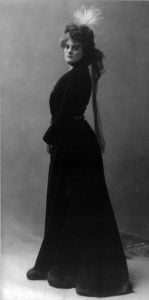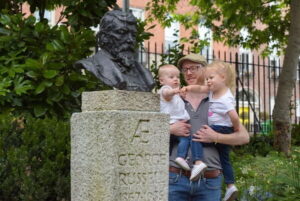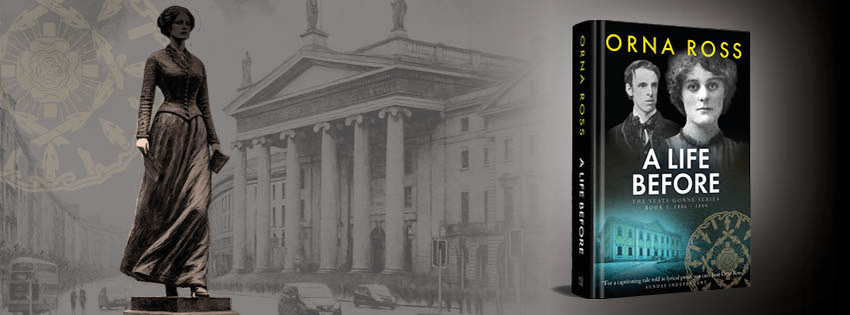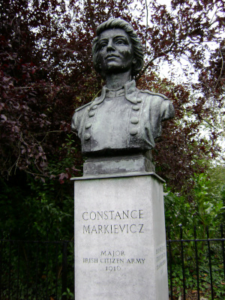Does Maud Gonne deserve a statue in Dublin? Of course she does and a group of writers and readers, artists and historians, are starting a campaign to bring this long overdue monument into being in a prominent Dublin location.
We believe Maud Gonne deserves this public acknowledgement as a testament to her profound and multifaceted influence on Irish history, culture, and politics, and her lifelong devotion to a variety of influential Irish causes.
A street monument would ensure Gonne's remarkable work would continue to inspire future generations–especially girls and young women who currently walk streets where statues and other public monuments are overwhelmingly male.
It's time to better acknowledge the pivotal role women have played in Ireland's history. In a city over-adorned with monuments celebrating historical male figures, a statue of Maud Gonne is long overdue.
There have always been many reasons to honor Maud Gonne with a statue, and in the eyes of her detractors, always been reasons not to (see below). But we are determined that this woman who was so ahead of her time should see her time come now.
Only now do we have the social and cultural framework to understand the significance of Maud Gonne's life. We expect this campaign to spark many fruitful conversations about diversity and remembrance.
You can join or support our campaign, More Than A Muse, here.
Maud Gonne: More Than A Muse
Most people know Gonne as a famous beauty, the muse of the Nobel laureate poet WB Yeats, who immortalised her in the twentieth century's finest love poetry in English but alhough she was fond of her friend Willie, he played a much smaller part in her life than she did in his.
She knew the world would remember her through his poems, and she valued WB's writings and friendship dearly, especially in the years where their aspirations for Ireland aligned, but the purpose of her own life was political and centered on a single cause: “the complete independence of Ireland.”
That was the toast she made at her wedding to another Irish natonalist, John MacBride, and that was the cause that held her for six decades.
She was a nationalist activist from her radicalisation at the beginning of her adulthood to the end of her life, but one who operated in an organic, freelance, and highly creative way. As is common among creatives, many of her friendships were built around her work, and her friendship with Yeats was just one of a matrix of contacts she cultivated to further the cause.
In addition to being a tireless Irish Republican activist who started or contributed to an astonishing range of projects across six decades, Gonne was also:
- a women's rights trailblazer who recognized the intertwined nature of national and gender-based oppressions
- an accomplished artist, writer, speaker, and performer who played an active role in the Irish Literary Renaissance as participant, and muse
- a generous patron who supported a great many socialist, nationalist and feminist causes with her personal monies.
- a dedicated occultist, who displayed second sight and a gifts for mediumship acknowledged by her mystical peers
- a loving mother, who organized other mothers into powerful symbolic protests against repression
- a beacon of inspiration to many besides the great poet, especially to women, children, prisoners, and social outcasts.
See this post for more about Gonne's social and political achievements.
Her personal qualities were equally remarkable. She was unimpressed by status at a time when Victorian society was at its most hierarchical, as unfailingly charming and kind to beggars as to kings. She was a natural hype artist and accomplished self-promoter, full of mischief, daring and fun. She's even been credited as having originated Goth sartorial style, with the extravagantly symbolic all-black outfits she wore!
The men and women who flocked to her causes were fulsome in their praise of her presence. She was a muse, undoubtedly, and to many more people than the famous poet. And a muse is a beautiful thing to be.
But she was more, so much more, than just that.
 Maud Gonne the Irish Nationalist
Maud Gonne the Irish Nationalist
Gonne's commitment to the Irish nationalist cause was deep and enduring. From her support of the landless in Mayo and Donegal during the Land Wars of the 1880s and 1890s, to her food programs for hungry children, to her support for prisoners, her brand of national activism always centered on those she called “The People”.
And most of all on those people who were most downtrodden and marginalized.
Her consistent presence and leadership in these weekly protests solidified her status as one of the most prominent and passionate advocates for Irish independence, often at great personal risk.
Maud Gonne the Feminist
As well as emotionally and financially supporting Irish nationalists like Douglas Hyde, Arthur Griffith, Willie Rooney, James Connolly and her husband, John MacBride, she was acutely aware that Ireland, as she put it, needed all her citizens and was losing out by irrationally barring women from their ranks.
Long before the global surge of feminism in the early 20th century, Gonne was advocating for the rights of women in Ireland. She recognized the intersectionality of national and gender oppressions, and her work laid the foundation for later Irish feminist movements.
She started two significant women's organisations. In 1900, she founded the Daughters of Ireland (Inghinidhe na hÉireann), dedicated to the promotion of Irish culture and the idea of a free Ireland, and twenty years later, in 1922, she was brought the three enduring interests of her life together when, with her friend Charlotte Despard, she co-founded the Women’s Prisoners' Defence League.
Maud Gonne The Peacemaker
Most people remember her as the fiery young woman who was happy to see coal bombs loaded onto English ships, or secretly planned with her new husband to assassinate King Edward VII during their honeymoon in Gibraltar. Like many an Irish nationalist, and indeed radical nationalists of all kinds, she despaired of the English authorities willingness to listen, and recognised that violence spoke louder than diplomacy.
So impassioned was she that “Maudgonning” became slang in Ireland for being over-passionate about a political cause.
But that was the earlier part of her life. The time she spent as a nurse at a French field hospital, aged 50, on the frontline of World War One changed all that.
From then on, her way became the way of peaceful protest.
For decades, through her 50s, 60s and into her 70s, Sunday after Sunday she would lead “The Mothers,” a resolute group of women united in their protest against the injustices perpetrated by the Irish Free State, through the streets of Dublin. Dressed in her signature somber attire, leading the way with fixed resolve, then climbing up on a stool or an orange box to denounce the latest atrocity.
The WPDL organized weekly demonstrations by The Mothers, a group of women activists, to protest against the ongoing repression of Irish nationalists within their own country. Every Sunday, these women dressed in mourning attire would lead silent processions on O'Connell Street, Dublin's main thoroughfare, carrying pictures of the executed leaders of the 1916 Easter Rising. Many of them, like herself, had been widowed by the executions.
This silent, yet deeply symbolic act of defiance became a potent symbol of Irish resistance. It was typical of Gonne's genius as an activist – understanding the power of visual imagery and public performance to stir emotions and galvanize public opinion.
Why Some Say Maud Gonne Doesn't Deserve A Statue
A few of the people approached about honoring Maud Gonne have raised the issue of her anti-Semitism, and pro-German support in World War II, as a reason why this project should not proceed or succeed.
It is true that Gonne's prejudice against the Jewish community, most vehemently expressed during the infamous Dreyfus affair, but held throughout her long life, is shocking to a modern reader. These views also seem incompatible with the socialist leanings that saw her actively involved with so many progressive causes: the Amnesty Association of Great Britain, the work with her friends James Connolly and Charlotte Despard for Dublin's poor and laboring classes, her dedication to those she called “the people”, the many speeches she gave about inequality, poverty and oppression throughout Ireland, England, France, the Netherlands, and Belgium.
Kim Bendheim, author of the recent Gonne biography The Fascination of What's Difficult, who describes herself as a WASPy Jew, has said, “I suspect that Gonne’s anti-Semitism… was as much a product of her upper-class British background as it was a political philosophy.”
I believe it was largely influenced by the beliefs of her lover, Lucien Millevoye, and the Boulangist right-wing circles in which she moved with him. As a young woman, Gonne fell deeply in love with this writer, politician, and supporter of the reactionary, anti-German, monarchist nationalism of freely embraced anti-Semitic and anti-Masonic conspiracy theories.
I go deeply into her motivations and influences in my novels, exploring how her particular brand of anti-Semitism grew out of this mileu at the heart of right-wing politics in fin-de-siecle Paris.
There is no attempt, either in my books, or in the campaign to see her honored with a statue, to claim that Maud Gonne was a perfect person. She was a complex, flawed, and multi-faceted individual… like us all. Though I find Gonne's views and expressions troubling at times, the holding of them does not cancel out her many social and political achievements.
If people had to be perfect to be honored for their achievements, we'd have to topple every statue in Dublin and strip away every accolade ever awarded.
There have always been reasons to denigrate Maud Gonne. As a young woman she was dismissed by unsympathetic nationalists as a rich English spy, or a self-serving drama queen. After she died she was dubbed a liar by scholars unsympathetic to the social conditions which forced her to hide her single-mother status. Her uncompromising political opinions, and flamboyant style as she aged, won her the soubriquet of “Maud Gonne Mad” in Dublin.
She has always been seen as “too” something to be fully accepted and acknowledged. Too bloodthirsty, too immoral, too divorced, too radical, too English, too feminist, too self-promoting, too extreme, too pathetic. Today, she is too anti-Semitic.
Maud Gonne the Multifaceted
More than anything, Gonne was an independent, happy to hold conflicting positions. She collaborated with the right-wing Millevoye, the moderate Yeats, and the socialist James Connolly but all to further one cause–that of Irish freedom. She judged everything, and everyone, by their support for and adherence to that cause, including the Irish Free State that emerged from the War of Independence.
In her autobiography, Gonne neatly summarized her philosophy: “I never willingly discouraged either a Dynamiter or a constitutionalist, a realist or a lyrical writer. My chief preoccupation was how their work could help forward the Irish Separatist movement.”
Unlike, say Constance Markievicz, who was a gun-carrying member of the Irish Citizen Army, Gonne was a freelancer, going wherever there was work to be done. Linking in with many but aligning completely with none.
Gonne's complexity is the very reason, I would argue, that her a statue is now particularly timely. She embodies the sort of objections those in power use to keep out those who are different–female, queer, colored, disabled or outsidered in some other way–but somehow get to be overlooked when the person is part of the established order.
In a time when we've begun to dismantle these double standards, the statue we envision would not only to honor the full legacy of Gonne's activism, artistic contributions, and politics but associated activity would serve to explore critical thinking about the politics of remembrance and commemoration.
Good enough is good enough. Women should not need to be saints to be honored, any more than men.
A statue of Maud Gonne would also begin to address a notable oversight in Irish public monuments, that needs addressing.
If you too believe Maud Gonne deserves a statue in Dublin, sign the petition here.
Almost No Street Statues of Women in Dublin
Dublin, a city rich in recorded history, has long honored its notable figures through various forms of commemoration, including statues and busts, but, as Simon Tierney recently noted, in his excellent article in The Irish Examiner, the public realm of Dublin “belongs to men.”
Tierney became interested in the representation of women when he became father to two girls. “I have come to realise just how male our built environment is…The office building where I work is named after a man. The same building is surrounded by William, George and Stephen… streets all named after men. Bridges, parks, buildings, streets and statues in Dublin virtually all commemorate historical men.” In short, he says, Dublin city centre “is a penis parade.”
- Not a single park bears the name of a woman.
- The two largest sports stadiums in the city are named in honor of men: Archbishop Thomas Croke and Henry Petty Fitzmaurice, the Third Marquess of Lansdowne.
- Dublin's three primary train stations all carry male names, commemorating Sean Houston, James Connolly, and Padraig Pearse.
- 23 out of 24 bridges that cross the Liffey are named for men.
- 27 of the 936 streets in the city centre are named after women– and of these, seventeen are saints' names and six of them are English queens.
And then there are the statues or street monuments, only five historical women are honored.
“When I crunched the numbers,” says Tierney, “I discovered that just 13% of the city centre’s statues represent historical women. This includes three separate iterations of Countess Markievicz, Catherine McCauley, Constance Lloyd Wilde, Veronica Guerin and Margaret Ball. The 44 remaining statues of historical figures all depict men.”

Simon Tierney and Daughters by the bust of George Russell. Pic: Moya Nolan for The Irish Examiner
Constance Markievicz, the artist, revolutionary and first female MP in Westminster (who has more than one). Sister Catherine McCauley, who founded the Sisters of Mercy. Constance Lloyd Wilde, writer and wife of the infamous Oscar, whose depiction is very much through the lens of her husband's life. The assassinated journalist Veronica Guerin, an old colleague of mine at the Irish Independent. And Margaret Ball, the Catholic martyr honored for harbouring priests in a time of persecution, who is part of a dual statue with her husband.
Not exactly representative of women's contribution to the city, across centuries.
A number of men, and Constance Markievicz, have more than one representation, and can be found in both statue and bust format. James Joyce, for example, is on North Earl Street as a statue, and in St Stephen’s Green, and on the campus of University College Dublin in bust form.
A recent commemoration of singer Luke Kelly Yet, a recent tribute to the singer Luke Kelly in Dublin led to the erection of not one but two statues in his honor, while his wife, the extraordinary Deirdre O’Connell who founded and managed the Focus Theatre, a significant small theatre that played a crucial role in Dublin’s cultural landscape in the dry years of the 60s, 70s and 80s, goes without public recognition.
It's really not okay.
“As my daughters grow up, will they be able to see themselves reflected in the city in which they live?” Tierney asks.
Where should the statue go?
Street monuments serve not only as memorials but also as sources of inspiration. For passers-by, especially women and girls, seeing a monument dedicated to a strong female figure like Maud Gonne would be empowering. At the most basic level, it symbolizes the possibility of making significant contributions to society, regardless of gender.
It would also be marvellous to have an associated education campaign around the issues raised by her life, inviting ongoing interaction and interpretation, evolving with the community's perceptions and experiences over time.
Where we'd most like to see the statue is on the pedestrian aisle opposite Dublin's GPO, walking in the direction that today's peaceful marches take so that when today's and tomorrow's protesters march down O'Connell Street, Maud Gonne marches with them.
Her presence in such a space would foster a continuous, lived relationship with her legacy, enhancing communal identity and collective memory in a way that she would utterly understand, ensuring her relevance across coming generations.
Its location will be a matter for Dublin City Council. Ruairí Ó Cuív, public art manager there is charged with developing and managing commissioning opportunities and applications. Ó Cuív says his office receives an average of two or three requests a year. “The city centre is really choc-a-bloc [with sculptures] and it amazes people there are so few suitable sites,” he says.
More Than A Muse: A Lasting Legacy
Maud Gonne's impact wasn't restricted to her own lifetime. Her work, ideals, and spirit influenced subsequent generations of Irish activists, writers, and artists and this statue will ensure that future generations remember and are inspired by her legacy.
To take one example. Gonne's activism against injustice, particularly that on behalf Irish political prisoners, deeply influenced her son, Sean MacBride, shaping his commitment to peace and human rights.
This influence laid the foundation for MacBride's role in co-founding Amnesty International, an organization focused on protecting human rights worldwide. Honoring Gonne would recognize her indirect yet profound influence in the creation of this leading human rights organization, highlighting the impact mothers can have on shaping their children's values and actions.
In this way, the statue would also celebrate the broader power of maternal influence.
A Statue for Maud Gonne
Maud Gonne's life was dedicated to the betterment of Ireland, to its culture, its independence, and its people. She was a beacon of hope, resilience, and unyielding spirit. She is the perfect role model for our time, illustrating the diverse roles women have played in history, beyond their relationships with men, and also beyond the need to be perfect as girls, as wives, as mothers.
This thought-provoking, vexing, and always enthralling whirlwind of a woman exerted an influence and impact that research continues to unveil, and that I've tried to bring to life in my novels… but that ultimately can only be guessed at.
It's time Maud Gonne took her rightful place in the heart of Dublin, a city she loved and fought for.
A statue would not only honour her, but also serve as a daily reminder of the ideals she stood for – ideals we're still working to enact.
We are on the move. We are going to make this happen. Come join us!
The “More than a Muse” campaign will use the crowdfunding platform Kickstarter to raise money and awareness. Sign up here to receive news and notifications.

